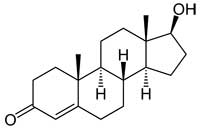Intersex: falling outside the norm Understand article
Male or female? What are the issues surrounding children for whom the answer is not clear? Researchers Eric Vilain and Melissa Hines hope to provide some of the answers.

image source: Wikimedia
Commons
“Is it a boy or a girl?” It is often the first question asked when a child is born, and it is widely assumed to be easy to answer. XY sex chromosomes = testicles and penis = boy; XX sex chromosomes = ovaries and vagina = girl. But it isn’t always that simple. Some children are born intersex, neither fully male nor fully female, but somewhere in between.
For example, they may appear female on the outside but have an internal anatomy more typical of males. Or they may have ambiguous genitalia: a girl may have a noticeably large clitoris, or lack a vaginal opening, or a boy may be born with a noticeably small penis, or with a scrotum that is divided so that it looks more like labia. Furthermore, some children are born with mosaic genetics, so that some of their cells have XX chromosomes and some have XY.
Why? Well, there are many different types of intersex and we don’t fully understand everything yet, but genetics and hormone levels in the mother’s womb during pregnancy are two known influences.

Hermaphroditus, the son of
Hermes and Aphrodite,
possessed physical traits of
both sexes
Image courtesy of Lady Lever
Art Gallery, Port Sunlight
Village Wirral, UK; public
domain image
To study the role that genetics plays in determining our sex, genes that are thought to be involved are modified and the outcome observed to see if the expected change occurred. For ethical reasons, this type of experiment cannot be conducted on humans, and so animals are used instead. Professor Eric Vilainw1, a physician and geneticist at the University of California, Los Angeles (UCLA) in the USA, is a researcher working in this area.
It used to be believed that if you had a Y chromosome, certain genes on it (known as pro-male genes) would ensure you were male; if you didn’t have a Y chromosome, you would not be male, and therefore – by default – female. Eric and his colleagues, however, overturned this theory when they found pro-female genes – genes that actually code for female characteristics (Jordan, 2003). “We showed that sex determination is much more about a delicate balance between male genes and female genes,” says Eric. It is now thought that a disturbance of this balance may have occurred in some types of intersex.
Another common cause of intersex in girls is a hormonal imbalance, where a genetic defect causes the adrenal gland of the fetus to produce very high levels of testosterone and other male hormones. This is called congenital adrenal hyperplasia (CAH). Professor Melissa Hinesw2, who researches the condition at the University of Cambridge in the UK, explains: “The testosterone causes the clitoris to grow larger so it looks somewhere between a clitoris and a penis, and it causes the labia to begin to fuse, so they look somewhere between labia and a scrotum.” This condition is identified at birth and treated, and the children are raised as girls. Treatment involves normalising the hormone levels, often followed by surgery for cosmetic reasons or to correct problems with the urethra and the vaginal opening.
Psychological impact
Although there are clinical treatments available for most types of intersex conditions, the matter is fraught with psychological and ethical issues. Eric is one researcher keen to find a better way to manage intersex and its perception in society.
“Parents are extremely stressed over the birth of a baby with ambiguous genitals,” he explains. An eagerness to ‘fix’ the child can lead to genital surgery very early in life – often in the first year. But whether this is the best thing for the child is unclear. As well as feeling that they would not have chosen to have the treatment themselves, children born intersex can have issues with shame and secrecy when they grow up. “A lot of patients I see with intersex conditions were not told what happened to them until very late in their adolescence, and they are often very angry at their family for having shielded them.” Early operations can also have a negative impact on sexual function later in life.

iStockphoto
So, would it be better not to interfere with nature? “We really don’t know,” says Eric. “There are a very small number of patients who have not been operated on, so we don’t know what life would be like living with ambiguous genitals, and maybe it’s also problematic psychologically.”
But how about gender identity: do children born intersex have problems feeling they truly belong to one sex or another? No, answers Eric. “Most intersex people I know are actually fine within a certain gender.”
Behavioural matters

image source: Flickr
Meanwhile, Melissa is keen to figure out what impact CAH has on gender behaviour – how the behaviour of intersex children compares to that of typical girls or boys – later in life. “We, and others, have found that the play behaviour of girls with CAH is different to that of other girls,” she explains. Her team assesses the toy choices made by three- to eight-year-old girls who had been treated for CAH immediately after birth. “Most girls tend to select dolls more than they would select vehicles or guns. Boys tend to grab the vehicles or the weapons. But girls with CAH are in between. They show more interest in the boy-typical toys and less interest in the girl-typical toys.”
This CAH behaviour research is part of a wider study led by Melissa, into gender development in all children. “Why do girls and boys like different toys? Why do children group together to play with others of the same sex? Why are boys, say, more rough and tumble than girls are?” are just some of the questions she is trying to answer. And comparing play behaviour and maternal hormone levels during pregnancy is her tool of choice.

testosterone, the principal
male sex hormone
Image courtesy of NEUROtiker;
image source: Wikimedia
Commons
Male fetuses produce a surge of testosterone between weeks 8 and 24 of pregnancy. This then tapers off, and apart from a small surge after birth, the testosterone levels in boys and girls remain approximately the same until puberty. In a study of 14 000 children, Melissa has found that mothers with higher testosterone levels during pregnancy were more likely to have girls who were more masculine within the normal range, and that mothers with lower testosterone levels were more likely to have girls who were less masculine.
Melissa’s observational studies allow the direct study of humans, in contrast to and complementing Eric’s genetic approach. Eric is hopeful that his, and other scientists’, research into intersex conditions will eventually lead to an easier life for those that fall outside society’s accepted parameters of normal. “I’ll feel happy if I achieved the goal of communicating to the general public that all those variants of sexual development, sexual orientation and gender identity are natural variants, and if, because we understand that they are natural variants, they become accepted in society.”
Sex determination in mice

Scientists at the European Molecular Biology Laboratory (EMBL)w4 and the UK’s National Institute for Medical Research have discovered that if the Foxl2 gene located on a non-sex chromosome is turned off, cells in the ovaries of adult female mice turn into cells typically found in testes.
It has traditionally been assumed that the female pathway – the development of ovaries and all the other traits that make a female – was a default: if an embryo had a gene called Sry, located on the Y chromosome, it would develop into a male; if not, then the result would be a female. But in adult animals it is the male pathway that needs to be actively suppressed, as Mathias Treier and his team at EMBL discovered.
“We were surprised by the results,” said Mathias. “When we switched off the Foxl2 gene in the ovaries of female mice, we expected the mice to stop producing oocytes, but what happened was much more dramatic: somatic cells that support the developing egg took on the characteristics of the cells that usually support developing sperm, and the gender-specific hormone-producing cells also switched from a female to a male cell type.”
These findings will have wide-ranging implications for reproductive medicine and may be used in the treatment of intersex children.
For further details, see the online interview with Mathias Treierw5 and the research paper (Uhlenhaut et al., 2009).
EMBL is a member of EIROforumw6, the publisher of Science in School.
Acknowledgements
This article is based on interviews given by Professor Eric Vilain and Professor Melissa Hines to the editors of Science in School, Dr Eleanor Hayes and Dr Marlene Rau. Some material was also taken from Melissa Hines’ lecturew3. The lecture and interviews took place during the conference ‘The Difference between the Sexes – from Biology to Behaviour’, at the European Molecular Biology Laboratory (EMBL) in Heidelberg, Germany.
References
- Jordan BK (2003) Wnt4 overexpression disrupts normal testicular vasculature and inhibits testosterone synthesis by repressing steroidogenic factor 1/β-catenin synergy. Proceedings of the National Academy of Sciences of the United States of America 100(19): 10866–10871.
- Uhlenhaut NH et al. (2009) Somatic sex reprogramming of adult ovaries to testes by FOXL2 ablation. Cell 139:6, 1130-1142.
Web References
- w1 – See the Gender Center website to find out more about the research of Eric Vilain and his team.
- w2 – To learn more about Melissa Hines’ research, see her website at the University of Cambridge.
- w3 – Watch a video of Melissa Hines’ talk.
- w4 – EMBL is Europe’s leading laboratory for basic research in molecular biology, with its headquarters in Heidelberg, Germany.
- w5 – Listen to Mathias Treier discussing his study of sex determination in mice.
- w6 – EIROforum is a collaboration between eight of Europe’s largest inter-governmental scientific research organisations, which combine their resources, facilities and expertise to support European science in reaching its full potential. As part of its education and outreach activities, EIROforum publishes Science in School.
Resources
- To learn more about intersex and its ethical and physiological implications, see the website of the Intersex Society of North America.
- The Howard Hughes Medical Institute (HHMI) website offers an interactive online activity to investigate sex and gender within the context of testing female athletes.
- The HHMI Biointeractive website offers a series of lectures on sex determination, given by specialists in the field and aimed at secondary-school students. The website also includes downloadable animations to accompany the lectures.
- Read the transcript of another interview with Eric Vilain on the Anneberg Learner website, which provides resources for school teachers.
Review
Intersex or ambiguous sexual phenotypes are not a common topic for discussion, at school or more generally, as an aura of embarrassment or shame often prohibits any mention of sexual pathology.
This article, based on interviews with two researchers in the field, introduces the reader to this tricky topic in clear language, highlighting some of the scientific and social aspects. I particularly appreciated the consideration of the psychological impact of the intersex condition and of the issues surrounding the treatment and rearing of intersex children.
As described in the article, the status and the management of the intersex condition is a highly controversial issue, so it can be profitably used for classroom discussion, especially with upper secondary-school students. It would be particularly applicable for biology (e.g. human reproduction), or in sex education or citizenship lessons. The discussion could involve many social, cultural, bio-ethical and legal aspects, including sex and gender identity, the rights and obligations of parents of an intersex child, the principle of autonomy of patients about medical treatments, and the social acceptance of intersex persons.
Potential comprehension questions include:
- Which of the following factors is not cited in the article as affecting sexual development in humans?
- X and Y chromosomes
- Pro-male and pro-female genes
- Alcohol exposure during pregnancy
- Hormone levels during pregnancy
- The topic of Melissa Hines’ research is:
- The play behaviour of CAH boys
- The play behaviour of CAH girls
- The role of genes in sexual development
- The play behaviour of pregnant women
Moreover, the web resources offer not only information and materials suitable for secondary-school students, but also further information about the study and management of intersex conditions.
I recommend this article to science teachers and upper secondary-school students who are keen to understand this commonly hidden condition and motivated to promote a better social acceptance of intersex people.
Giulia Realdon, Italy





